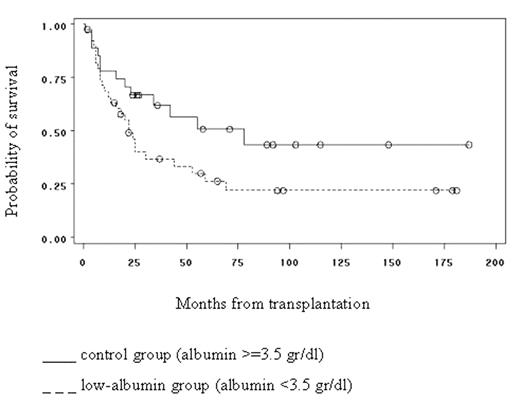Abstract
Background: Management of R/R-HL has been disappointing with salvage chemotherapy alone. Although controversy remains over the best time to perform a transplant, auto-BM/PSCT is considered an acceptable salvage therapeutic option for patients (pts) with R/R-HL. Hypoalbuminemia is one of the seven adverse prognostic factors for newly diagnosed pts with HL who receive chemotherapy according to the international prognostic factors project on advanced HL. The prognostic significance of hypoalbuminemia in pts with R/R-HL undergoing salvage auto-BM/PSCT is less clearly defined at the present time.
Objective: To evaluate the prognostic significance of hypoalbuminemia in pts with R/R-HL who undergo salvage auto-BM/PSCT.
Methods: A retrospective, single-institution study of consecutive pts with R/R-HL who received auto-BM/PSCT at the University of Oklahoma over the last 19 years (1985– 2004) was performed. The serum albumin level during hospital admission for transplant that was closest to, but before, high-dose chemotherapy was recorded and used for this analysis. Hypoalbuminemia was defined as a serum albumin level < 3.5 g/dl. Overall survival (OS) was defined as the time period in months from the day of transplant until death, or the last day of follow-up. Survival curves were estimated according to the Kaplan-Meier method, and were compared between the two groups (control group [≥3.5 g/dl] and low albumin group [< 3.5 g/dl]) with the use of the log-rank test. Median survivals of the two groups were also compared by using Wilcoxon-Mann-Whitney test. One-sided P-value of < 0.05 was considered statistically significant. SAS® sofware (version 8.0; Carry, NC) was used for statistical analysis.
Results: 66 patients (40 males, 26 females) were identified, who were 13–69 years old (median 29 years) at the time of transplant. 40 pts (61%) died during follow-up, 4 pts (6%) were lost to follow-up at 15, 27, 58 and 103 months after transplant, and 22 pts (33%) are alive at the time of this analysis (7/30/04), 2–187 months (median 68 months) after transplant. Median survival for the control group (n1=27, 13/27 died) was 78 months (95% CI: 23 - N/A months) and for the low-albumin group (n2=39, 27/39 died) was 22 months (95% CI: 13– 44 months). The difference between overall survival curves (figure) and also the difference between median survivals approached, but did not reach statistical significance (p-values for log-rank and Wilcoxon-Mann-Whitney tests, 0.0632 and 0.0565, respectively).
Conclusion: Our results suggest a trend for a worse outcome among pts who undergo salvage auto-BM/PSCT for R/R-HL with low serum albumin (<3.5 g/dl) before transplant. The lack of statistical significance in this analysis is likely related to the relatively limited sample size and the retrospective nature of the study. A larger, prospective analysis evaluating the potential adverse prognostic value of hypoalbuminemia in pts with R/R-HL undergoing auto-BM/PSCT is warranted.
Author notes
Corresponding author


This feature is available to Subscribers Only
Sign In or Create an Account Close Modal